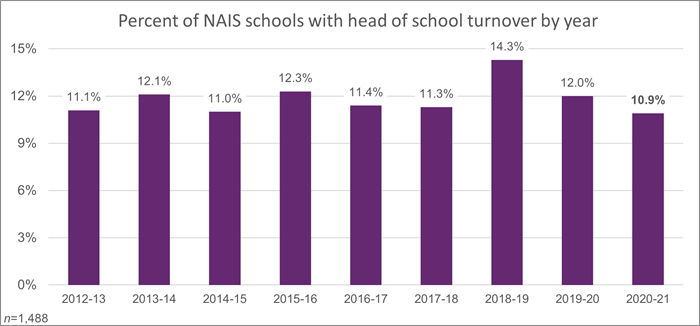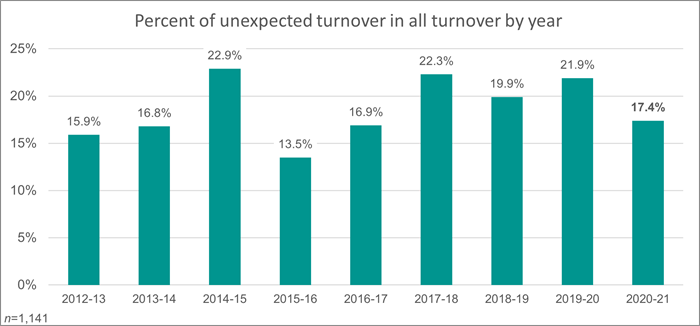Turnover isn’t the issue at hand; after all, new leadership can bring fresh ideas. The issue, however, is unexpected turnover, or what NAIS defines as “any nonrenewal or termination occurring within three years of hire not directly related to retirement, interim succession, or unethical or illegal behavior.” These brief tenures are concerning: A leader gone too quickly doesn’t have the time to build connections, take ownership, and create lasting change. And an unexpected change can weaken trust in the school’s leadership, threaten stability at the board level, and ultimately compromise the school’s educational program.
While these unexpected-turnover related concerns started to surface well before the pandemic, there’s even more cause for concern now with heads making unprecedented difficult decisions in an increasingly complex time. To better understand the issue, we reviewed the FAHST data, looked at our current data, and examined unexpected turnover through the lens of hiring—there’s often a disconnect between what heads and boards understand about their expectations of each other. This disconnect can have damaging effects.
Head Turnover: What the Data Say
Challenges in higher education often foreshadow challenges for independent schools. Luckily, it appears that the pandemic hasn’t pushed out many college presidents: transition rates are within a normal range for the sector, and president retirement rates appear to be down. Data are supporting the same trend in independent schools. According to DASL data for the 2020–2021 school year, which included data from 1,481 schools, head turnover writ large has remained flat compared with the previous year. In 2019–2020, 12% of NAIS schools experienced head turnover, while 11% did so in 2020–2021. Save for a spike in 2019-2020, turnover rates have been consistent year over year, ranging between 11% and 12.5%. In fact, the 2020-2021 data represent the lowest turnover rate in the nine years studied.
Data and Analysis for School Leadership (DASL), custom report
NAIS has seen a slight rise in unexpected turnover since the early 2010s. For 2020–2021, 17.4% of schools in a turnover situation replaced a head who had been in their position for three years or less. This number has dropped 4.5 percentage points from the year prior. However, this number has fluctuated over time, ultimately rising just 1.5 percentage points from 2012–2013. On average, unexpected turnover affects just 2% of all NAIS schools each year and 15% of NAIS schools over the past nine years.

Data and Analysis for School Leadership (DASL), custom report
Though unexpected turnover may appear to affect a small number of schools, we can parse the DASL data another way: One in five new heads leave their position after three years or less. This mirrors the national turnover rate of public school principals but is still a disconcertingly high number of heads. What is happening to drive out 20% of new heads before they make a positive mark on their institutions? The FAHST survey helped diagnose the many factors affecting turnover, including a mismatch in expectations between the head and the board about what the role of head of school entails. For example, 95% of board chairs agreed or strongly agreed that their board set achievable goals for the head of school and that the board and head collaborated on their prioritization. However, only 77% of heads of school agreed. That nearly 20 percentage point gap belies misunderstanding or disagreement between many heads and their boards on what the head’s role entails, as well as what is the board’s role in helping the head succeed. Left unchecked, this discord can lead to a head’s unexpected departure, voluntary or involuntarily. The head may feel that the board expects the impossible, while the board thinks that the head is not meeting agreed-upon metrics of success. But what got them to this point of mismatched expectations?
Why Boards Hire Heads
Equally important to understanding what causes unexpected turnover is understanding the reasons why a head was hired. How did the search committee select a particular candidate, and what did they say to convince them to accept? What role does the search process play in creating issues in a headship?In fall 2020, NAIS conducted research to study what boards of trustees are looking for when they search for a new head of school. This project included interviews with current and former board chairs who led search committees for a new head of school, putting them in the best position to speak to the decision-making process of the committee. Using the Jobs-to-Be-Done methodology, NAIS uncovered three Jobs—a combination of context, motivations, and desired outcomes—that trustees are hoping to fulfill in the head search. Each Job is an archetype that explains common desires and motivations for schools in similar circumstances that can help boards and prospective heads clarify their own search processes. They can be summarized using boards’ context and desired outcome in their specific situation:
- When our school has a specific issue that needs to be addressed (enrollment, fundraising, etc.) and the current head of school is unequipped to handle the issue (or doesn’t believe there is an issue), help us find a suitable replacement with a proven record of success so we can turn our school around.
- When we are confident in the strategy, we have set for our school but our current head of school has chosen to leave, help us find a suitable replacement who will reinforce the values of our school and execute our existing strategic vision so we can continue along our existing path.
- When we believe our school is succeeding but we acknowledge that staying relevant requires (some) change, help us find a head of school who will bring a fresh perspective and suggest changes so we can maintain our relevance while still executing our school’s existing vision.
Before writing a job description or submitting an application, both the board and prospective head of school should study these Jobs. Boards can use them to help prompt discussion about what their school needs in a new leader, while prospective heads can use them to help unpack high-level language and understand what their prospective employer wants out of them. For example, a board might say it wants a “visionary.” When a prospective head hears that in the interview, they may think the board wants someone who can lead the charge to create an entirely new strategic plan. But that’s not exactly it; it might be that half the board wants someone who will contribute fresh ideas to the existing strategic plan, and the other half wants someone who can serve more as a thought leader in the independent school community without really challenging the existing strategy. Everyone thinks they’re on the same page, when they’re not.
When the candidate gets the job and brings new strategies to the board, trustees may be frustrated to varying degrees at the attempts to overhaul the existing plan. After a contentious executive session, the head’s contract isn’t renewed and the head leaves—all because of a misunderstanding over a key piece of the job description. If the board had decided on clearer language or the candidate had known to probe further for the board’s definition of visionary, such a situation could have been avoided.
Good governance thrives on a successful foundation of mutual understanding between head and board. By understanding how the leadership search process works in independent schools, those who guide the process can help ensure a strong start for new heads through a clear partnership whose terms, goals, and boundaries are made apparent before the first interview. In doing so, schools can help turn around the high levels of unexpected turnover and ensure their new leader can thrive in tandem with their trustees for years to come.
The full results and recommendations from this recent JTBD research can be found in the report, What are Boards Searching for When they Hire an Independent School Leader?